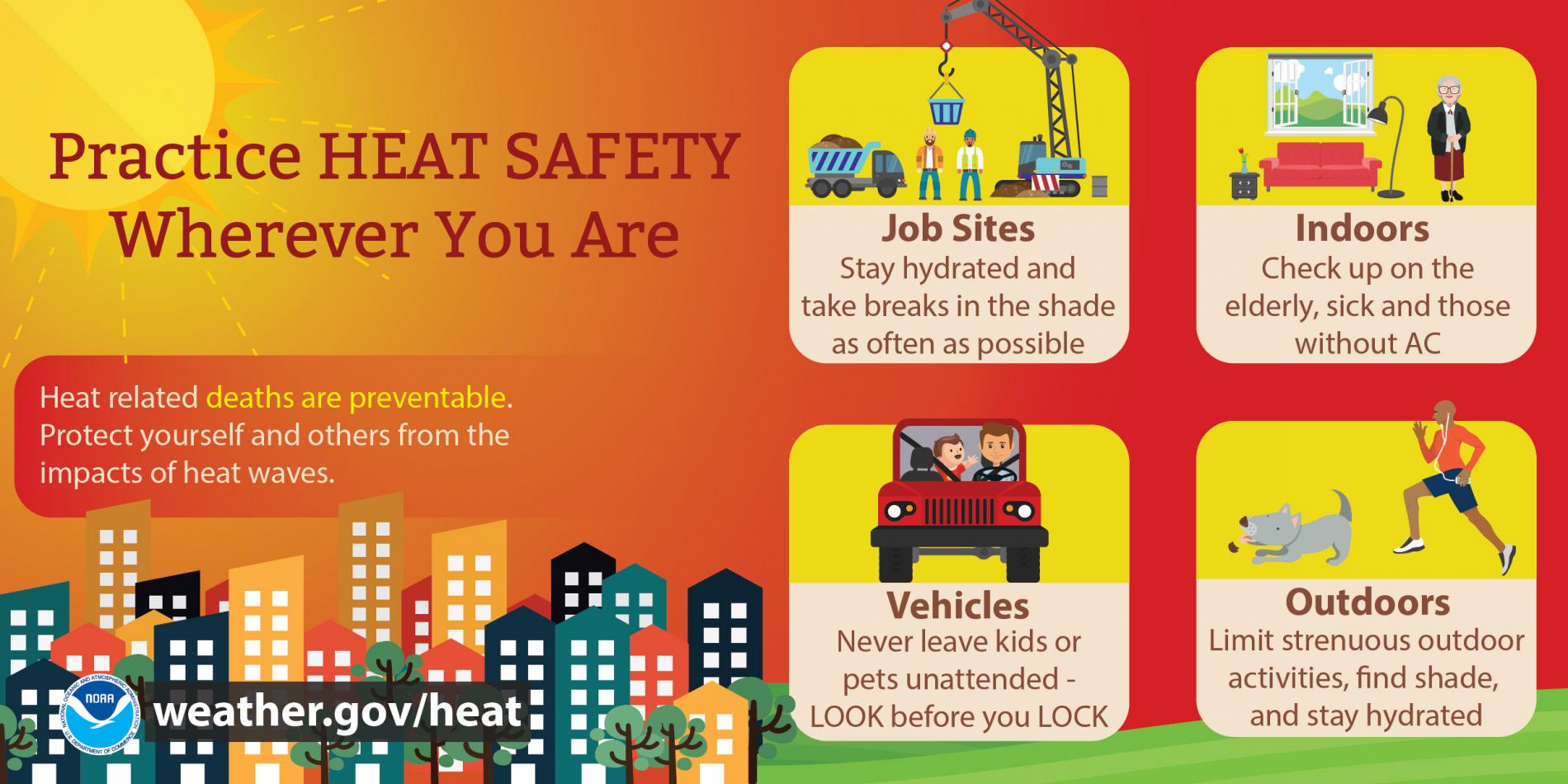Excessive Heat

A heat wave is an extended period of extreme heat, often with high humidity. These conditions can be dangerous and even life-threatening without proper precautions.
BEFORE EXCESSIVE HEAT
-
To begin preparing, you should build an emergency kit and make a family communications plan.
-
Learn about the types of medical conditions that can result from heat waves, and the proper first aid measures that should be taken.
-
Get to know your neighbors; the elderly and others with medical conditions. They are more likely to become victims of excessive heat and may need help.
-
Check to see if your home's cooling system is working properly.
-
Make sure your home is well insulated and that you have weather stripping around your doors and window sills to keep the cool air inside.
-
Cover windows that receive morning or afternoon sun with drapes, shades, awnings, or louvers.
HEAT RELATED ILLNESSES
-
Heat Cramps - Muscular pains and spasms due to heavy exertion. Although heat cramps are the least severe, they are often the first signal that the body is having trouble with the heat.
-
If these symptoms are observed:
-
-
Get the person to a cooler location and remove excess clothing.
-
Give cool sports drinks. Do not give liquids with caffeine or alcohol. Discontinue liquids if victim is nauseated.
-
Seek medical attention if: the cramps do not subside in an hour, the victim has heart problems, or is on a low-sodium diet
-
Heat exhaustion Typically occurs when people exercise heavily or work in a hot, humid place where body fluids are lost through heavy sweating. Symptoms include heavy sweating, paleness, muscle cramps, tiredness, weakness, dizziness, headaches, nausea, fainting. If not treated, the victim's condition will worsen.
-
If these symptoms are observed:
-
Move victim to air-conditioned place and lie down. Loosen or remove clothing.
-
Cool the victim by placing them in a cool shower or bath, or by applying cool, wet cloths.
-
Give sips of water or cool sports drinks containing salt and sugar. Do not give liquids with caffeine or alcohol. Discontinue liquids if victim is nauseated.
-
Seek immediate medical attention if there is no improvement, the victim is unable to take fluids, vomiting occurs, or any symptoms are severe.
-
-
-
Heat stroke is a life-threatening condition. The victim's temperature control system, which produces sweating to cool the body, stops working. The body temperature can rise so high that brain damage and death may result if the body is not cooled quickly. Symptoms include extremely high body temperature above 103°F, hot dry red skin, rapid strong pulse, headache, dizziness, nausea, confusion, unconsciousness.
-
If these symptoms ae observed:
-
Call 911 or emergency medical services, or get the victim to a hospital immediately. Delay can be fatal.
-
Until the emergency medical personnel arrive on scene or during transport to the hospital, move the person to a cooler location, cool by removing clothing, bath, sponging, applying a cold we sheet.
-
Do not give the victim fluids to drink.
-
-
DURING EXCESSIVE HEAT
-
Stay indoors as much as possible and limit exposure to the sun.
-
All PWC Libraries are designated as cooling resources during their normal business hours.
-
-
Drink plenty of fluids and replace salts and minerals in your body. Anyone on a fluid-restricted diet or who has a problem with fluid retention should consult a doctor before increasing liquid intake. People with epilepsy or heart, kidney, or liver disease should also consult a doctor before increasing liquid intake. A sports beverage can replace the salt and minerals you lose in sweat. Avoid using salt tablets unless directed to do so by a physician.
-
Limit intake of alcoholic beverages.
-
Monitor the County's Emergency Information Page for updates on any additional cooling resources that may be available during extreme heat events.
-
Dress in loose-fitting, lightweight, and light-colored clothes that cover as much skin as possible. Protect face and head by wearing a wide-brimmed hat.
-
Spend time in air-conditioned places. If you cannot afford an air conditioner, spend some time each day in an air-conditioned environment such as public libraries, shopping malls or other indoor public spaces.
-
Stay on the lowest floor, out of the sunshine if air conditioning is not available.
-
Check on family, friends, and neighbors who do not have air conditioning and who spend much of their time alone.
-
Never leave children or pets alone in closed vehicles.
-
Avoid strenuous work during the warmest part of the day. Use a buddy system when working in extreme heat, and take frequent breaks.
-
Eat well-balanced, light, and regular meals. Hot, heavy meals add heat to your body. Avoid using salt tablets unless directed to do so by a physician.
HEAT WATCHES, WARNINGS, AND ADVISORIES
Familiarize yourself with these terms to help identify an extreme heat hazard:
-
Heat Wave - Prolonged period of excessive heat, often combined with excessive humidity.
-
Heat Index - A number in degrees Fahrenheit (F) that tells how hot it feels when relative humidity is added to the air temperature. Exposure to full sunshine can increase the heat index by 15 degrees.
-
Excessive Heat Watch - Conditions are favorable for an excessive heat event to meet or exceed local Excessive Heat Warning criteria in the next 24 to 72 hours.
-
Excessive Heat Warning - Heat Index values are forecast to meet or exceed locally defined warning criteria for at least 2 days (daytime highs=105-110° Fahrenheit).
-
Heat Advisory - Heat Index values are forecast to meet locally defined advisory criteria for 1 to 2 days (daytime highs=100-105° Fahrenheit).
ADDITIONAL INFORMATION
For more heat safety tips, view the National Weather Service's resources at visit https://www.weather.gov/safety/heat.
For information about heat safety at worksites, visit the Occupational Safety and Health Administration's Heat Illness Prevention Campaign at https://www.osha.gov/heat/index.html.